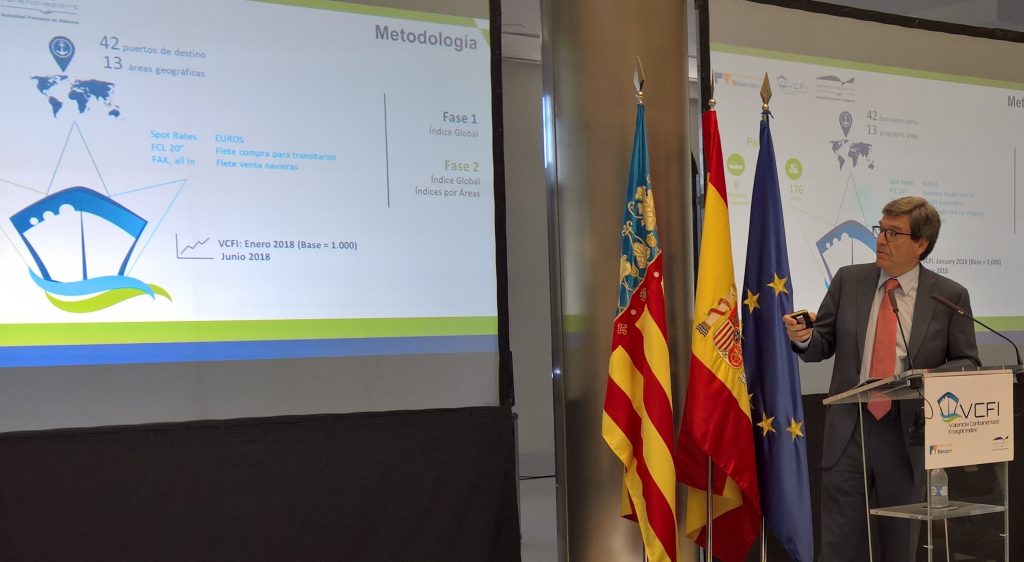
The Valencia Containerised Freight Index (VCFI) has been developed by the Valencia Port Authority and the Valenciaport Foundation.
The VCFI will be published on the second Friday of each month.
The new index fills the gap in the western Mediterranean, an area that accounts for 3.8% of world trade but lacks its own indicator for export freight rates.
The international container export market has, as of today, a new reference in the evolution of maritime freight rates. This is the VCFI: the Valencia Containerised Freight Index. An index that will record the freight rates of several maritime routes connecting the Mediterranean with other destinations in the world. It will be a global reference. The VCFI has been developed by the Port Authority of Valencia (APV for its acronym in Spanish) and the Valenciaport Foundation, and was presented this morning to the Port Community in the Clock Building of the Port of Valencia.
The VCFI is intended to be a reference index in the Western Mediterranean, just as the Shanghai Containerized Freight Index is for the Asian area. “The VCFI thus aims to fill a gap and a need for indicators that existed in the Mediterranean area with the greatest commercial traffic, given that despite representing 3.8% of world trade, it did not have its own indicator on the evolution of cargo or export freight rates to date”, according to the president of the Port Authority of Valencia (APV), Aurelio Martínez.
“Spain—explained the president of the APV—is an exporting power. Last year it handled 2,868,120 full TEUs of cargo, which represents 1.4% of world export traffic (250 million TEUs of cargo, full) and has no indicator to show us the evolution of freight rates”.
“On this basis—explained Aurelio Martínez—the VCFI is destined to become the main indicator in the Mediterranean for this type of traffic, given the similarity of freight rates”.
The VCFI is presented as a statistical magnitude based on the contribution of confidential data from companies operating in the market. Specifically, the panel of informants is made up of 8 shipping companies and 4 freight forwarders with a wide presence in the international market. It collects—in a first stage—the aggregate evolution of the freight rates with respect to an initial reference moment, established in January 2018, period in which the index takes a value of 1,000.
The VCFI will be published on a regular basis on the second Friday of each month at 12:00 CET (or CEST when applicable).
The VCFI project will be audited annually, in order to certify that the Valenciaport Foundation guarantees the statistical secrecy, that the VCFI methodology is faithfully followed and that the information published is truthful.
The presentation of the VCFI took place today after midday in the emblematic Clock Building of the Port of Valencia; a place of encounter and celebration of the most important events of the Port Community of Valencia.
Antonio Torregrosa, Project Manager of the Valenciaport Foundation, opened the presentation of the VCFI by expressing his satisfaction with a product that “once again demonstrates the leadership of Valenciaport on a global scale by promoting pioneering initiatives at the service of the port logistics community”.
The new index was presented by the President of the Port Authority of Valencia and of the Valenciaport Foundation, Aurelio Martínez.
Martinez—Professor of Economics—thanked the technicians of the Foundation for their work and explained the opportunity it represents for Valenciaport to assume the commitment to provide an international reference for maritime transport.
“Valenciaport—he said—is the leading port in the Mediterranean in container traffic; and with 4.83 million TEUs managed in 2017 we closed the year as the leading port in Spain Therefore, what we seek with the VCFI index is to provide guidance to market players on the evolution of export freight rates from the port of Valencia; and to be the reference for certain Mediterranean routes”.

“The VCFI—he added—provides value-added information on a key factor in defining port competitiveness, such as freight rates. But it also makes available to the port community information that up to now has been treated as confidential. This transparency exercise will help the different users of the port to make better decisions and will be of great help to shippers, as they will have a composite index that will set the market trend for the cost of their export operations. Ultimately, an index that will favour the functioning of a more transparent market with better information for decision making”.
13 geographical areas and 42 ports
In its initial phase, the VCFI consists of a aggregate composite index and, in subsequent methodological developments, sub-indexes will be constructed in greater detail with a breakdown by the geographical areas defined in the construction of the index. In particular, Valenciaport’s export destinations have been grouped into 13 geographic areas that correspond to the main traffic corridors from Valencia. Within these areas 42 ports have been selected to represent 60% of the export container traffic from Valenciaport and whose rates will serve as a reference for calculating the index.
| Geographic area VCFI | Reference ports |
| WESTERN MEDITERRANEAN | Casablanca (MA), El Djazair (DZ), Tunisia (TN) |
| ATLANTIC EUROPE | Felixstowe (GB), Hamburg (DE), Antwerp (BE) |
| EASTERN MEDITERRANEAN | Alexandria (EG) Ashdod (IL) Piraeus (GR) Istanbul (TR) |
| FAR EAST | Shanghai (CN), Hong Kong (HK), Port Kelang (MY), Singapore (SG), Busan (KR), Tokyo (JP), Kaohsiung (TW), Bangkok (TH), Ho Chi Minh City (VN) |
| MIDDLE EAST | Jeddah (SA), Jebel Ali (AE) |
| USA – ATLANTIC CANADA | New York (US), Montreal (CA), Houston (US), Miami (US) |
| CENTRAL AMERICA AND CARIBBEAN | Veracruz (MX), Cartagena (CO) Altamira (MX), Caucedo (OJ) |
| ATLANTIC LATIN AMERICA | Santos (BR), Buenos Aires (AR) |
| WEST AFRICA | Luanda (AO), Bata (GQ), Dakar (SN) |
| AFRICA EAST COAST | Durban (ZA), Port Elisabeth (ZA) |
| PACIFIC LATIN AMERICA | Callao (PE), San Antonio (CL) |
| INDIAN SUBCONTINENT | Nhava Sheva (IN), Kandla (IN) |
| BALTIC COUNTRIES | Saint Petersburg (RU), Helsinki (FI) |

